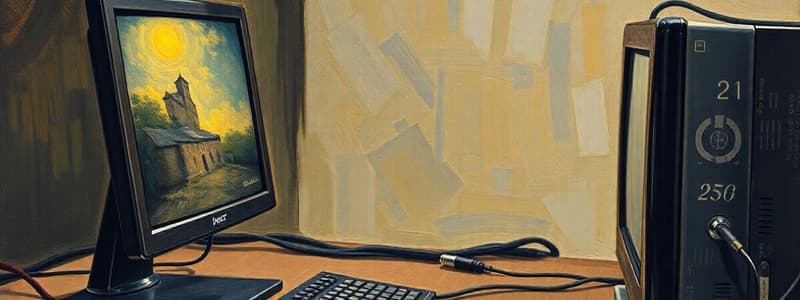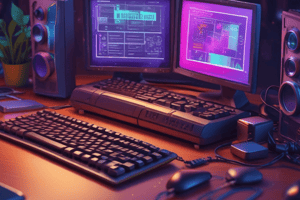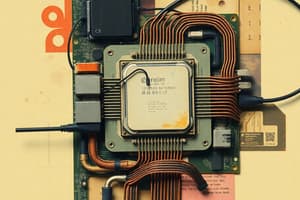Podcast
Questions and Answers
Which component is NOT typically part of a local area network (LAN)?
Which component is NOT typically part of a local area network (LAN)?
- Router (correct)
- Workstation
- Communication channel
- Server
What is a defining characteristic of a wide area network (WAN)?
What is a defining characteristic of a wide area network (WAN)?
- Connects geographically separated areas (correct)
- Is generally faster than LANs
- Connects devices in limited areas like homes or small offices
- Used primarily for local data sharing
Which of the following services is offered by the Internet?
Which of the following services is offered by the Internet?
- Electronic mail (correct)
- Local file storage
- Direct hardware access
- Intranet access
Which file type is NOT mentioned as a possible output that can be saved by a program?
Which file type is NOT mentioned as a possible output that can be saved by a program?
What distinguishes an intranet from the World Wide Web?
What distinguishes an intranet from the World Wide Web?
Which component is considered hardware?
Which component is considered hardware?
What is the primary role of an operating system?
What is the primary role of an operating system?
Which of the following best defines a program?
Which of the following best defines a program?
Which storage device is not categorized as a removable medium?
Which storage device is not categorized as a removable medium?
Which of the following is NOT a type of port or connection on a computer?
Which of the following is NOT a type of port or connection on a computer?
What type of data can programs process?
What type of data can programs process?
Which of the following describes computer peripherals?
Which of the following describes computer peripherals?
To properly shut down a computer, which action should be performed?
To properly shut down a computer, which action should be performed?
What device is primarily responsible for interpreting and executing commands given to a computer?
What device is primarily responsible for interpreting and executing commands given to a computer?
Which of the following components is considered an input device?
Which of the following components is considered an input device?
What is the main function of the motherboard in a computer?
What is the main function of the motherboard in a computer?
Which type of memory is volatile and loses its content when the computer is turned off?
Which type of memory is volatile and loses its content when the computer is turned off?
Which component converts audio signals into a digital audio file?
Which component converts audio signals into a digital audio file?
What role does the Central Processing Unit (CPU) have in relation to memory?
What role does the Central Processing Unit (CPU) have in relation to memory?
Which of the following is NOT a main part of a computer?
Which of the following is NOT a main part of a computer?
Which hardware component is primarily responsible for displaying information visually on a computer?
Which hardware component is primarily responsible for displaying information visually on a computer?
Flashcards are hidden until you start studying
Study Notes
Introduction to Computer Basics
- Lesson Objectives:
- Define a computer.
- Describe the importance of computers in today's world.
- Identify the main parts of a computer.
- Identify the primary hardware components of a computer.
The Role of Computers
- Computers are essential tools in various sectors:
- Business and industry
- Publication field
- Education field
- Government organizations
- Medical field
- Science field
- Entertainment field
Parts of a Computer
-
Input Devices:
- Devices that allow users to provide information to the computer.
- Examples: Keyboard, Mouse, Microphone, Scanner, Webcam.
-
Output Devices:
- Devices that display or present information processed by the computer.
- Examples: Monitor, Printer, Speaker/Headphone.
-
Central Processing Unit (CPU) and Memory:
- CPU: Interprets and executes commands given to the computer. Also known as the processor. Major brands include Intel and AMD.
- Memory: Stores and retrieves information used by the CPU. Two types:
- RAM (Random Access Memory): Main memory for temporary storage of commands and data.
- ROM (Read Only Memory): Retains its contents even after the computer is turned off.
-
Motherboard:
- Main circuit board inside the computer.
- Contains electronic circuits and components.
- Connects input, output, and processing devices (CPU, Memory, Hard Drive, DVD Drive).
- Directs the CPU's operation.
-
Expansion Cards:
- Video Card: Connects to the monitor, responsible for displaying information.
- Network Interface Card (NIC): Enables communication between computers.
- Sound Card: Converts audio signals (microphone or audio tape) into computer audio files.
-
Storage Devices:
- Used for storing data permanently.
- Examples: Hard Disk, Flash Drive, CD-ROM, DVD-ROM.
-
Ports and Connections:
- Universal Serial Bus (USB) Port: Standard connection for various devices.
- FireWire: Similar to USB, but faster.
- Network Port (Ethernet): For connecting to a network.
- Parallel Port and Serial Port: Older connection types.
- Display Adapter: Connects to a monitor.
- Power: Provides electrical supply.
Using a Computer
- Turning On: Press the power button on the system unit.
- Log On: Access the operating system using a username and password.
- Creating and Saving Files: Computers allow users to create, modify, and store files containing data.
- Shutting Down: Click "Start" and select "Shut Down."
Common Computer Terminology
-
Hardware: Physical components of a computer (keyboard, mouse, motherboard, monitor, hard disk, etc.).
-
Operating System: Most important software on the computer. Controls and manages the hardware. Provides an interface for interaction with the computer. Ensures proper functioning. Example: Windows XP.
-
Program/Application: Software that uses the hardware and operating system (platform) to perform tasks.
-
Data: Information processed by programs. Can be text, graphics, audio, or video.
-
Network: Group of computers and devices linked together. Facilitates information sharing, data sharing, and device sharing (printers). Components: Server, Workstation, Communication Channel.
-
LAN (Local Area Network): Connects devices within a limited area (home, small office).
-
WAN (Wide Area Network): Connects devices in geographically dispersed locations. Used to connect networks across countries. The internet is an example of a WAN.
-
Internet: Global collection of public networks connected for information exchange. Offers services like file transfers and email.
-
World Wide Web (WWW): Another internet service, also known as the Web.
-
Intranet: Similar to the Web but accessible only to authorized users within an organization.
Studying That Suits You
Use AI to generate personalized quizzes and flashcards to suit your learning preferences.




